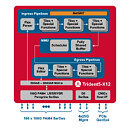- Joined
- Aug 19, 2017
- Messages
- 2,626 (0.98/day)
Artificial intelligence has been a hot topic this year, and everything is now an AI processor, from CPUs to GPUs, NPUs, and many others. However, it was only a matter of time before we saw an integration of AI processing elements into the networking chips. Today, Broadcom announced its new Ethernet switching silicon called Trident 5-X12. The Trident 5-X12 delivers 16 Tb/s of bandwidth, double that of the previous Trident generation while adding support for fast 800G ports for connection to Tomahawk 5 spine switch chips. The 5-X12 is software-upgradable and optimized for dense 1RU top-of-rack designs, enabling configurations with up to 48x200G downstream server ports and 8x800G upstream fabric ports. The 800G support is added using 100G-PAM4 SerDes, which enables up to 4 m DAC and linear optics.
However, this is not only a switch chip on its own. Broadcom has added AI processing elements in an inference engine called NetGNT (Networking General-purpose Neural-network Traffic-analyzer). It can detect common traffic patterns and optimize data movement across the chip. Specifically, the company has listed an example of the system doing AI/ML workloads. In that case, NetGNT performs intelligent traffic analysis to avoid network congestion in these workloads. For example, it can detect the so-called "incast" patterns in real-time, where many flows converge simultaneously on the same port. By recognizing the start of incast early, NetGNT can invoke hardware-based congestion control techniques to prevent performance degradation without added latency.


View at TechPowerUp Main Site | Source
However, this is not only a switch chip on its own. Broadcom has added AI processing elements in an inference engine called NetGNT (Networking General-purpose Neural-network Traffic-analyzer). It can detect common traffic patterns and optimize data movement across the chip. Specifically, the company has listed an example of the system doing AI/ML workloads. In that case, NetGNT performs intelligent traffic analysis to avoid network congestion in these workloads. For example, it can detect the so-called "incast" patterns in real-time, where many flows converge simultaneously on the same port. By recognizing the start of incast early, NetGNT can invoke hardware-based congestion control techniques to prevent performance degradation without added latency.


View at TechPowerUp Main Site | Source


 .
.


